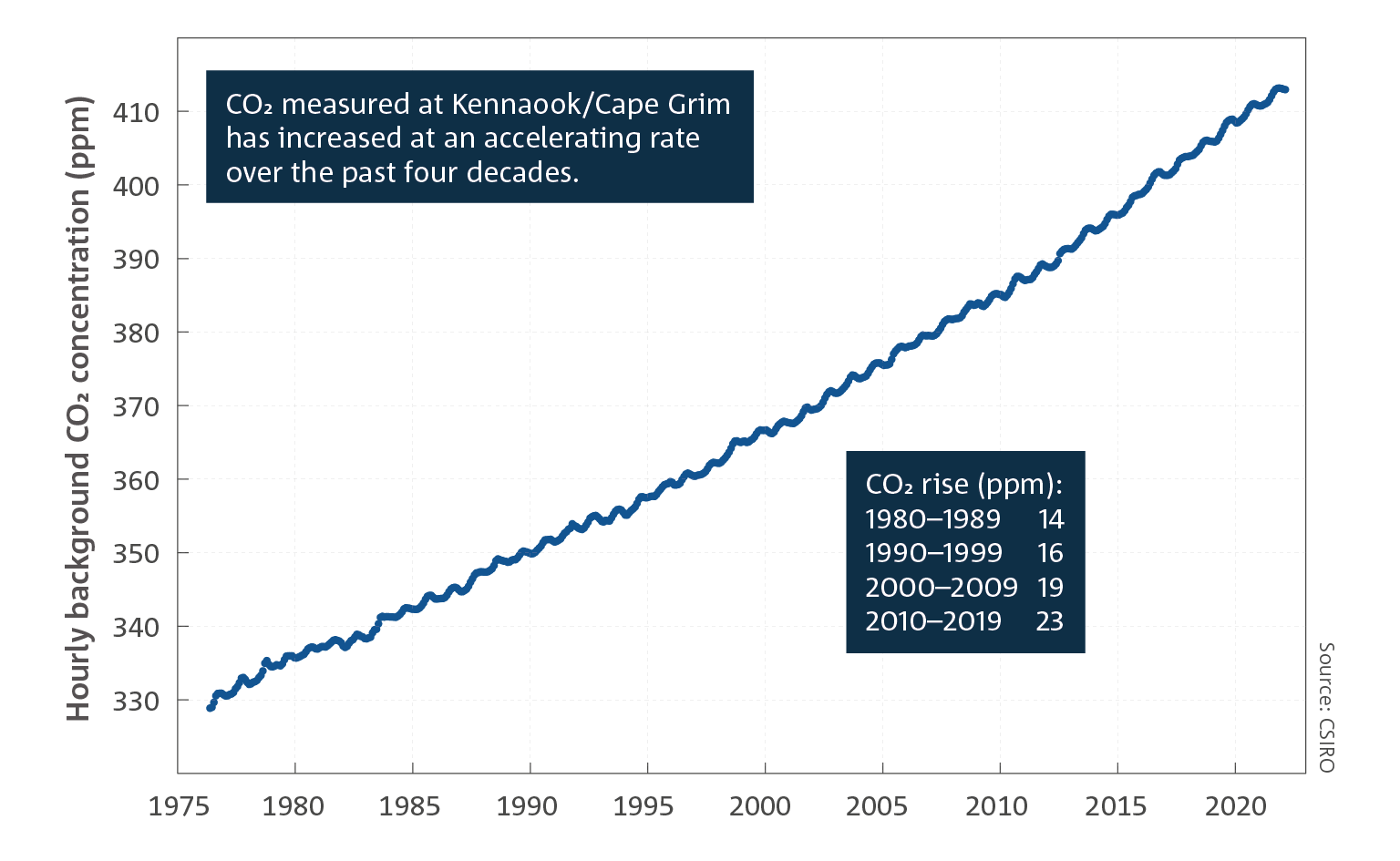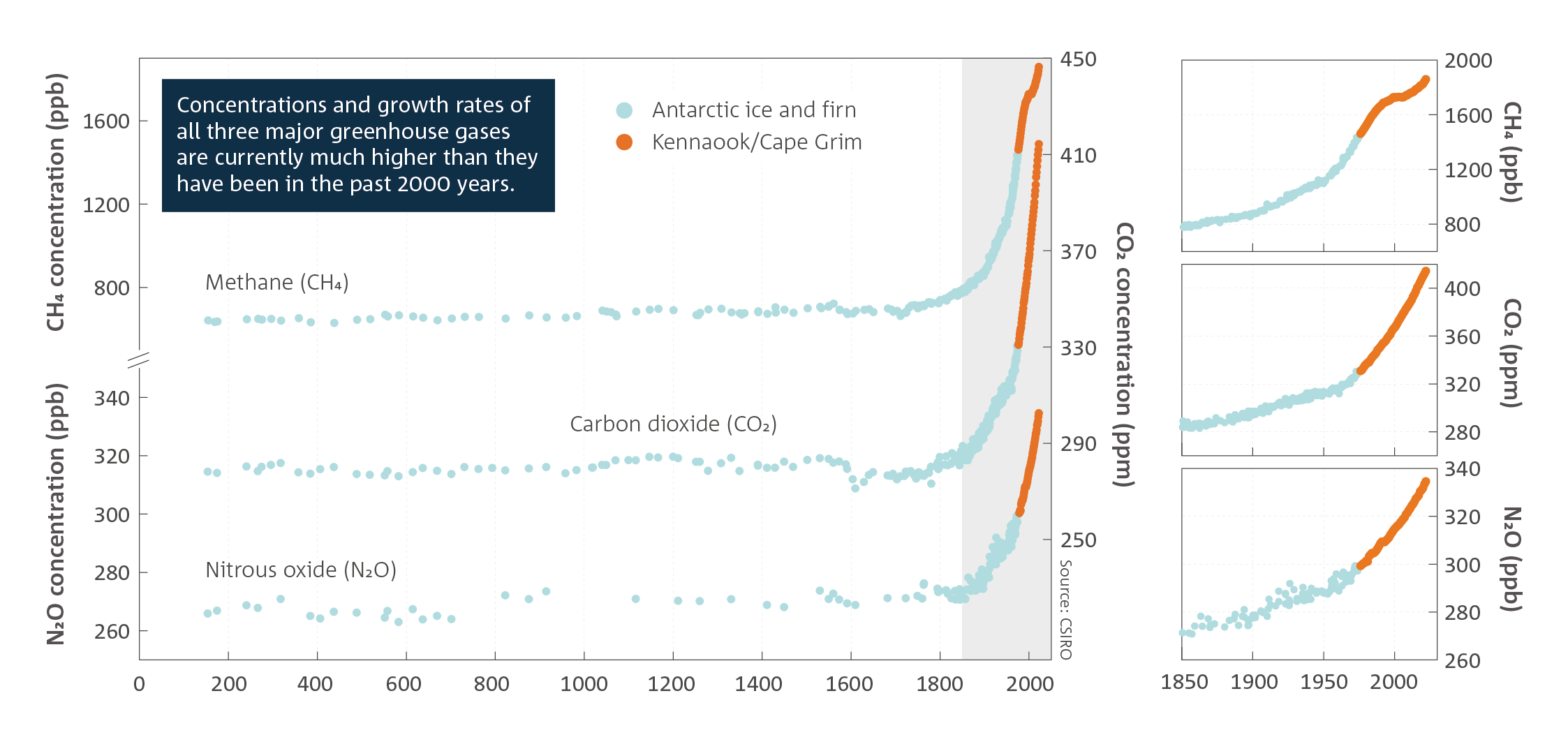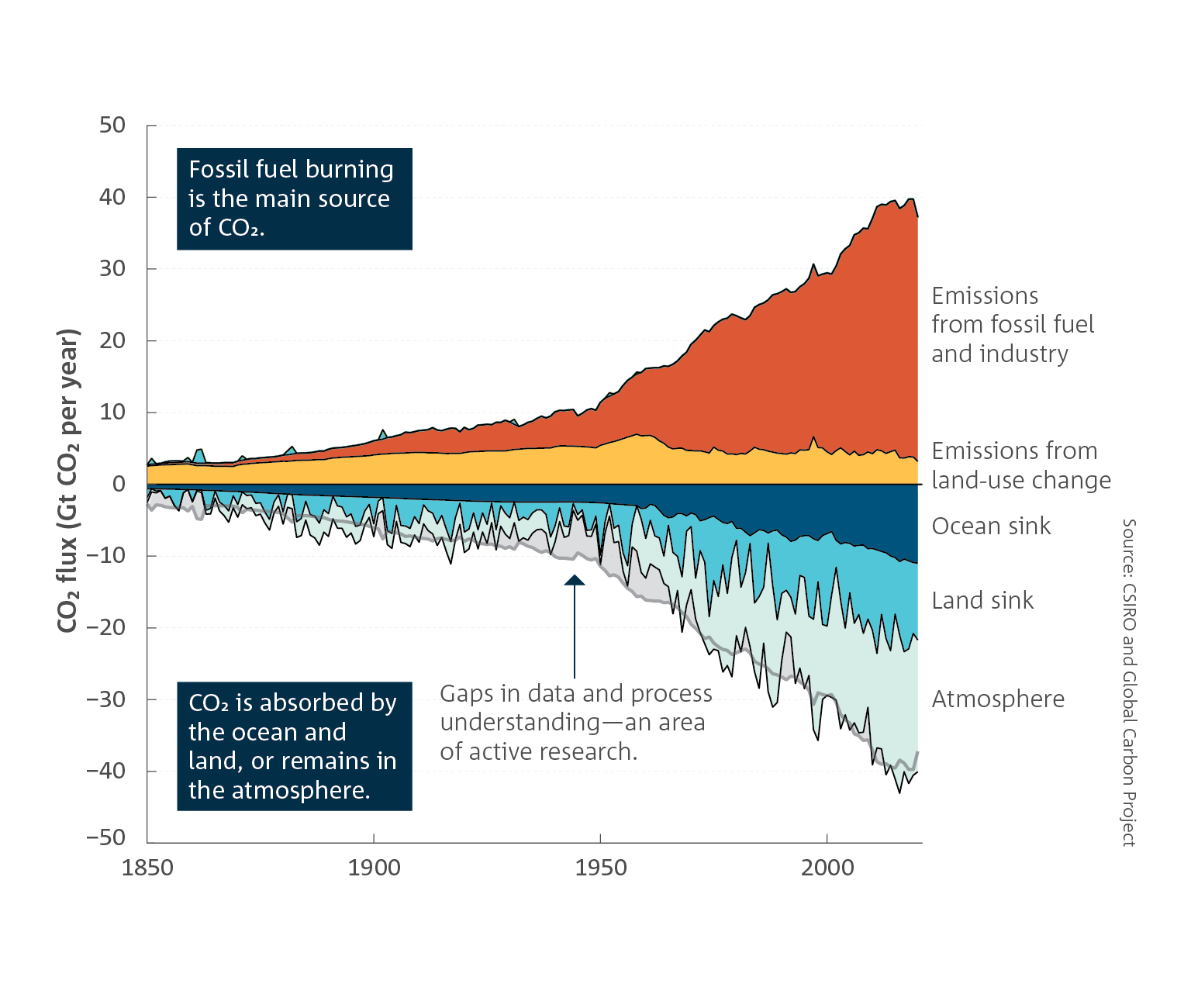Greenhouse gases
- Global average concentrations of all major long-lived greenhouse gases continue to rise in the atmosphere, driving further climate change.
- The rate of CO2 accumulation in the atmosphere has increased every decade since atmospheric measurements began. Global average annual mean CO2 concentration reached 414.4 ppm in 2021. Adding all greenhouse gases together, concentrations reached 516 ppm of CO2-e.
- Over the past two years, the amounts of atmospheric methane and nitrous oxide have grown very rapidly.
The global annual mean CO2 concentration in 2021 was 414.4 ppm—a 50 per cent increase from the concentration of 277 ppm in 1750.
Other long-lived greenhouse gases also contribute to global warming. The most significant of the non-CO2 greenhouse gases are methane and nitrous oxide. In 2021, the global annual mean concentration of methane was 1890 parts per billion (ppb), while for nitrous oxide it was 334 ppb. Respectively, these are rises of 158 per cent and 22 per cent above their 1750 levels of 731 ppb and 273 ppb.
Global mean surface warming in the future will be largely determined by cumulative emissions of CO2 and the other long-lived greenhouse gases. Because of the thermal inertia of the oceans and the fact that these gases persist in the atmosphere for decades to centuries, the Earth system is committed to further warming.
Methane is the second most important greenhouse gas and is emitted from a wide range of sources. Natural microbial decomposition of organic matter in wetlands is the largest single source of methane emissions.
However, human activities are responsible for emissions from fossil fuel extraction and use (including natural gas), farming of livestock, rice cultivation and waste from landfills and agriculture.
Together, these sources account for about 60 per cent of global methane emissions. Because methane is 83 times more potent at trapping heat than CO2 over a 20-year time period, but persists in the atmosphere for only around a decade, efforts to reduce methane emissions will have a large impact on reducing warming on a short timescale. Therefore, reducing atmospheric methane is an important component of pathways to manage climate change. However, in 2020 and 2021, atmospheric methane concentration increased by 13 and 20 ppb, respectively. Increases of these sizes are unparalleled in three decades of direct atmospheric measurements.
Nitrous oxide has a global warming potential 273 times that of CO2. It is emitted naturally from the land and oceans. Use of nitrogenous fertilisers is the largest anthropogenic source, and it has been rising steadily in recent decades, leading to accelerating atmospheric growth rates. Throughout 2020 and 2021, nitrous oxide has grown in the atmosphere by more than 1.3 ppb per year. The growth rate of nitrous oxide, measured directly or through Antarctic ice and compressed snow (firn), has been less than 1 ppb per year for at least the past 2000 years except for five of the past eight years.
Actions to reduce the impact of the COVID-19 pandemic led to a reduction in CO2 emissions from human activities in many countries during 2020 (and to a lesser extent 2021), relative to 2019. In April 2020, during the period of most severe and widespread restrictions globally, daily CO2 emissions are estimated to have dropped by 17 per cent. This sharp decline was short‑lived, so global annual CO2 emissions for all of 2020 were only around 6 per cent lower than in 2019. A drop in CO2 emissions, such as was seen in 2020, has not been recorded since the two world wars and the Great Depression, during the first half of the past century.

Ongoing fossil fuel use and land-use change mean that CO2 has continued to grow in the atmosphere throughout 2020 and 2021 at a rate of more than 2 ppm per year, similar to the past decade. Substantial global emissions reductions, of the order of those seen in 2020 but that are sustained for 5–10 years, will be required before there is an attributable decline in the atmospheric growth rate of CO2. Global net zero emissions will be required to stop greenhouse gas accumulation in the atmosphere, abating climate change.
The Kennaook/Cape Grim Baseline Air Pollution Station (pictured opposite), located at the north-west tip of Tasmania, is the Southern Hemisphere’s key greenhouse gas monitoring station in the World Meteorological Organization’s Global Atmosphere Watch program. It has been running continuously for 46 years.
Atmospheric concentrations of CO2 measured at Kennaook/Cape Grim continue to show an upward trend with the decadal growth rates accelerating since measurements began. This is consistent with other stations globally. The annual average CO2 at Kennaook/Cape Grim reached 412 ppm in 2021, slightly lower than the global average of 414.4 ppm.
Kennaook/Cape Grim greenhouse gas concentrations are typically lower than the global averages because most emissions originate in the Northern Hemisphere. It takes many months for Northern Hemisphere air, with higher greenhouse gas concentrations, to mix into the Southern Hemisphere and appear in the Kennaook/Cape Grim observations.
Globally averaged atmospheric concentrations of all major long-lived greenhouse gases and a group of synthetic greenhouse gases (industrially produced for uses such as refrigeration) continue to rise.
The cumulative climate effect of all the long-lived greenhouse gases in the atmosphere can be expressed as radiative forcing. Radiative forcing is the enhancement of the net radiation. It quantifies the increase in energy in the climate system due to the addition of long-lived greenhouse gases into the atmosphere relative to 1750. Because it is the most abundant greenhouse gas, CO2 is the largest contributor to radiative forcing. Other gases make substantial and growing contributions.

The combined impact of all greenhouse gases can be converted to a CO2-e atmospheric concentration, by considering the global warming potential (ability to trap heat in the atmosphere) of each gas and its concentration. The annual average CO2-e measured at Kennaook/Cape Grim reached 511 ppm in 2021, and 516 ppm globally. This is approaching twice the pre-industrial level of 278 ppm CO2-e in 1750.
Measurements of air extracted from Antarctic ice cores and firn extend the atmospheric composition record back before direct observations commenced.
These measurements show that all three major greenhouse gases (CO2, methane and nitrous oxide) were relatively stable for most of the past 2000 years, before beginning to rise in the late 18th century, coincident with industrialisation. All three major greenhouse gases have been increasing at an accelerating pace since around 1850 and are now rising at historically unprecedented rates.
The isotopes of carbon in atmospheric CO2 are used to identify its different sources. Measurements of carbon-13 and carbon-14, relative to carbon-12, confirm that the increase in CO2 concentration since 1800 originates principally from fossil fuel and land clearing emissions.
Global Carbon Budget
Global emissions of CO2 from fossil fuel use and land-use change continued to increase in recent decades, reaching 40.6 ± 2.9 gigatonnes per year of CO2 in 2019 (1 Gt is equal to 1 billion tonnes).

In the decade from 2011–20, average global anthropogenic CO2 emissions were 38.9 ± 1.8 Gt CO2 per year. Around 90 per cent of global CO2 emissions were from fossil fuels and 10 per cent from land-use change.
The uptake of carbon into ocean and land sinks has grown in response to the higher accumulation of CO2 in the atmosphere.
In the decade from 2011–20, the land and ocean sinks removed on average 29 per cent and 26 per cent of all anthropogenic emissions, respectively. Combined, these sinks are removing more than half of all CO2 emissions from human activities and thus are slowing the rate of increase in atmospheric CO2 and the pace of climate change.
Despite this important uptake by the natural CO2 sinks, CO2 has continued to accumulate in the atmosphere, growing by 18.6 Gt CO2 per year over the decade from 2011–20.
Greenhouse gases
- Global average concentrations of all major long-lived greenhouse gases continue to rise in the atmosphere, driving further climate change.
- The rate of CO2 accumulation in the atmosphere has increased every decade since atmospheric measurements began. Global average annual mean CO2 concentration reached 414.4 ppm in 2021. Adding all greenhouse gases together, concentrations reached 516 ppm of CO2-e.
- Over the past two years, the amounts of atmospheric methane and nitrous oxide have grown very rapidly.
The global annual mean CO2 concentration in 2021 was 414.4 ppm—a 50 per cent increase from the concentration of 277 ppm in 1750.
Other long-lived greenhouse gases also contribute to global warming. The most significant of the non-CO2 greenhouse gases are methane and nitrous oxide. In 2021, the global annual mean concentration of methane was 1890 parts per billion (ppb), while for nitrous oxide it was 334 ppb. Respectively, these are rises of 158 per cent and 22 per cent above their 1750 levels of 731 ppb and 273 ppb.
Global mean surface warming in the future will be largely determined by cumulative emissions of CO2 and the other long-lived greenhouse gases. Because of the thermal inertia of the oceans and the fact that these gases persist in the atmosphere for decades to centuries, the Earth system is committed to further warming.
Methane is the second most important greenhouse gas and is emitted from a wide range of sources. Natural microbial decomposition of organic matter in wetlands is the largest single source of methane emissions.
However, human activities are responsible for emissions from fossil fuel extraction and use (including natural gas), farming of livestock, rice cultivation and waste from landfills and agriculture.
Together, these sources account for about 60 per cent of global methane emissions. Because methane is 83 times more potent at trapping heat than CO2 over a 20-year time period, but persists in the atmosphere for only around a decade, efforts to reduce methane emissions will have a large impact on reducing warming on a short timescale. Therefore, reducing atmospheric methane is an important component of pathways to manage climate change. However, in 2020 and 2021, atmospheric methane concentration increased by 13 and 20 ppb, respectively. Increases of these sizes are unparalleled in three decades of direct atmospheric measurements.
Nitrous oxide has a global warming potential 273 times that of CO2. It is emitted naturally from the land and oceans. Use of nitrogenous fertilisers is the largest anthropogenic source, and it has been rising steadily in recent decades, leading to accelerating atmospheric growth rates. Throughout 2020 and 2021, nitrous oxide has grown in the atmosphere by more than 1.3 ppb per year. The growth rate of nitrous oxide, measured directly or through Antarctic ice and compressed snow (firn), has been less than 1 ppb per year for at least the past 2000 years except for five of the past eight years.
Actions to reduce the impact of the COVID-19 pandemic led to a reduction in CO2 emissions from human activities in many countries during 2020 (and to a lesser extent 2021), relative to 2019. In April 2020, during the period of most severe and widespread restrictions globally, daily CO2 emissions are estimated to have dropped by 17 per cent. This sharp decline was short‑lived, so global annual CO2 emissions for all of 2020 were only around 6 per cent lower than in 2019. A drop in CO2 emissions, such as was seen in 2020, has not been recorded since the two world wars and the Great Depression, during the first half of the past century.
FIGURE 1: The increase of energy into the climate system of 3.4 watts per square metre, compared to 1750, is due to long-lived greenhouse gases. Stacked area chart which shows the radiative forcing of the following: synthetic greenhouse gases, nitrous oxide, methane and carbon dioxide, from 1900 to 2021. For a full description of this figure please contact: www.csiro.au/contact FIGURE 2: Global CO2 equivalent reached 516 ppm in 2021. Global mean CO2 reached 414 ppm in 2021. Line chart which shows two lines (CO2 and CO2 equivalent) with rising carbon dioxide concentration (ppm) between 1900 to 2021. For a full description of this figure please contact: www.csiro.au/contact
Ongoing fossil fuel use and land-use change mean that CO2 has continued to grow in the atmosphere throughout 2020 and 2021 at a rate of more than 2 ppm per year, similar to the past decade. Substantial global emissions reductions, of the order of those seen in 2020 but that are sustained for 5–10 years, will be required before there is an attributable decline in the atmospheric growth rate of CO2. Global net zero emissions will be required to stop greenhouse gas accumulation in the atmosphere, abating climate change.
The Kennaook/Cape Grim Baseline Air Pollution Station (pictured opposite), located at the north-west tip of Tasmania, is the Southern Hemisphere’s key greenhouse gas monitoring station in the World Meteorological Organization’s Global Atmosphere Watch program. It has been running continuously for 46 years.
Atmospheric concentrations of CO2 measured at Kennaook/Cape Grim continue to show an upward trend with the decadal growth rates accelerating since measurements began. This is consistent with other stations globally. The annual average CO2 at Kennaook/Cape Grim reached 412 ppm in 2021, slightly lower than the global average of 414.4 ppm.
Kennaook/Cape Grim greenhouse gas concentrations are typically lower than the global averages because most emissions originate in the Northern Hemisphere. It takes many months for Northern Hemisphere air, with higher greenhouse gas concentrations, to mix into the Southern Hemisphere and appear in the Kennaook/Cape Grim observations.
Globally averaged atmospheric concentrations of all major long-lived greenhouse gases and a group of synthetic greenhouse gases (industrially produced for uses such as refrigeration) continue to rise.
The cumulative climate effect of all the long-lived greenhouse gases in the atmosphere can be expressed as radiative forcing. Radiative forcing is the enhancement of the net radiation. It quantifies the increase in energy in the climate system due to the addition of long-lived greenhouse gases into the atmosphere relative to 1750. Because it is the most abundant greenhouse gas, CO2 is the largest contributor to radiative forcing. Other gases make substantial and growing contributions.
Figure 1: Concentrations and growth rates of all three major greenhouse gases are currently much higher than they have been in the past 2000 years. Time series plot showing atmospheric concentrations of methane (top), carbon dioxide (middle) and nitrous oxide (bottom) over the past 2000 years. Concentrations of all three gases were reasonably constant until the 19th Century, at which point concentrations began to increase at an accelerating rate over time. For a full description of this figure please contact: www.csiro.au/contact Figure 2: Fossil fuel burning is the main source of CO2. CO2 is absorbed by the ocean and land, or remains in the atmosphere. Stacked area chart which shows CO2 fluxes from different sources (Gt CO2 per year) between 1850 and 2021. Sources include: emissions from fossil fuel and industry, emissions from land-use change, ocean sink, land sink and atmosphere. For a full description of this figure please contact: www.csiro.au/contact
The combined impact of all greenhouse gases can be converted to a CO2-e atmospheric concentration, by considering the global warming potential (ability to trap heat in the atmosphere) of each gas and its concentration. The annual average CO2-e measured at Kennaook/Cape Grim reached 511 ppm in 2021, and 516 ppm globally. This is approaching twice the pre-industrial level of 278 ppm CO2-e in 1750.
Measurements of air extracted from Antarctic ice cores and firn extend the atmospheric composition record back before direct observations commenced.
These measurements show that all three major greenhouse gases (CO2, methane and nitrous oxide) were relatively stable for most of the past 2000 years, before beginning to rise in the late 18th century, coincident with industrialisation. All three major greenhouse gases have been increasing at an accelerating pace since around 1850 and are now rising at historically unprecedented rates.
The isotopes of carbon in atmospheric CO2 are used to identify its different sources. Measurements of carbon-13 and carbon-14, relative to carbon-12, confirm that the increase in CO2 concentration since 1800 originates principally from fossil fuel and land clearing emissions.
Global Carbon Budget
Global emissions of CO2 from fossil fuel use and land-use change continued to increase in recent decades, reaching 40.6 ± 2.9 gigatonnes per year of CO2 in 2019 (1 Gt is equal to 1 billion tonnes).
In the decade from 2011–20, average global anthropogenic CO2 emissions were 38.9 ± 1.8 Gt CO2 per year. Around 90 per cent of global CO2 emissions were from fossil fuels and 10 per cent from land-use change.
The uptake of carbon into ocean and land sinks has grown in response to the higher accumulation of CO2 in the atmosphere.
In the decade from 2011–20, the land and ocean sinks removed on average 29 per cent and 26 per cent of all anthropogenic emissions, respectively. Combined, these sinks are removing more than half of all CO2 emissions from human activities and thus are slowing the rate of increase in atmospheric CO2 and the pace of climate change.
Despite this important uptake by the natural CO2 sinks, CO2 has continued to accumulate in the atmosphere, growing by 18.6 Gt CO2 per year over the decade from 2011–20.
